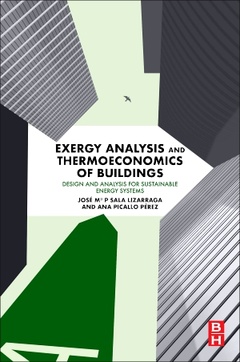Exergy Analysis and Thermoeconomics of Buildings Design and Analysis for Sustainable Energy Systems
Auteurs : Sala-Lizarraga Jose M, Picallo-Perez Ana

Quantifying exergy losses in the energy supply system of buildings reveals the potential for energy improvement, which cannot be discovered using conventional energy analysis. Thermoeconomics combines economic and thermodynamic analysis by applying the concept of cost (an economic concept) to exergy, as exergy is a thermodynamic property fit for this purpose, in that it combines the quantity of energy with its quality factor.
Exergy Analysis and Thermoeconomics of Buildings applies exergy analysis methods and thermoeconomics to the built environment. The mechanisms of heat transfer throughout the envelope of buildings are analyzed from an exergy perspective and then to the building thermal installations, analyzing the different components, such as condensing boilers, absorption refrigerators, microcogeneration plants, etc., including solar installations and finally the thermal facilities as a whole.
A detailed analysis of the cost formation process is presented, which has its physical roots firmly planted in the second law of thermodynamics. The basic principles and the rules of cost allocation, in energy units (exergy cost), in monetary units (exergoeconomic cost), and in CO2 emissions (exergoenvironmental cost), based on the so-called Exergy Cost Theory are presented and applied to thermal installations of buildings.
Clear and rigorous in its exposition, Exergy Analysis and Thermoeconomics of Buildings discusses exergy analysis and thermoeconomics and the role they could play in the analysis and design of building components, either the envelope or the thermal facilities, as well as the diagnosis of thermal installations. This book moves progressively from introducing the basic concepts to applying them.
Exergy Analysis and Thermoeconomics of Buildings provides examples of specific cases throughout this book. These cases include real data, so that the results obtained are useful to interpret the inefficiencies and losses that truly occur in actual installations; hence, the assessment of their effects encourages the manner to improve efficiency.
Section A Foundations of exergy theory1 Efficient buildings and the arguments for incorporating exergy2 Quality of energy and exergy3 Calculation of physical and chemical exergySection B Exergy analysis of the envelope and thermal installations4 Exergy analysis of heat transmission in buildings5 Exergy analysis of thermal facilities equipment in buildings (I)6 Exergy analysis of thermal equipment in buildings (II)Section C Thermoeconomics and symbolic thermoeconomics. Costs and diagnosis of installations7 Thermoeconomics of the thermal installations of buildings8 Symbolic Thermoeconomics applied to thermal facilities9 Operational diagnosis of thermal installations in buildingsSection D Sustainability and exergy in buildings10 Sustainability and exergy in buildings11 Application of exergecoeconomic and exergoenvironmental analysis to several cases of building thermal systems Section E Design and thermoeconomics in buildings12 Optimization and design of the envelope and thermal installations of buildingsSection F Exergy in the thermodynamics of continuous media13 Exergy in continuous media. Application to equipment design
His professional life has been devoted mainly to lecturing and research. Since 1983 he is Professor of Thermodynamics and Physical Chemistry at the School of Engineering of Bilbao, University of the Basque Country. He also worked for several years as Technical Director for an engineering company dedicated mainly to the development of power plant projects.
His lines of research are energy analysis and the simulation of industrial equipment and processes, as well as energy efficiency in buildings. He has published more than one hundred articles in international journals, has presented communications in more than eighty international congresses, is the author of three patents and has written numerous technical reports and twelve books on thermodynamics and on cogeneration.
Ana Picallo Perez, currently an interim university professor (at ETSI Bilbao) and a researcher at the consolidated ENEDI group, got the PhD in Energy Efficiency and Sustainability in Engineering and Architecture area in 01/2019 thanks to the Basque Government's predoctoral fellowship.
In addition, she previously participated as a Personal Researcher Contracted by the School of Engineering of Bilbao.
Her research areas are related to testing, analysis and optimization of building energy supply systems, Thermoeconomics and diagnosis application in buildings. Likewise, according to those areas, she made 6 publications in JCR journals, a book chapter and she contributed in more than 15 international and national congresses since 2015.
She did 3 quarterly stays: first one at Technische Universität Berlin (2017), second at L'Università degli Studi di Palermo (2018) and third at L'Università
- Applies exergy analysis methods for the installation of building thermal facilities equipment components, including pipes, valves, heat exchangers, boilers and heat pumps
- Helps readers determine the operational costs of heating and cooling building systems
- Includes exergy analysis methods that are devoted to absorption refrigerators, adsorption cooling systems, basic air conditioning processes, ventilation systems and solar systems, either thermal and PV
- Discusses the direct application of exergy analysis concepts, including examples of buildings with typical heating, DHW and air conditioning installations
Date de parution : 09-2019
Ouvrage de 1114 p.
15x22.8 cm
Thèmes d’Exergy Analysis and Thermoeconomics of Buildings :
Mots-clés :
Absorption refrigerators; Adsorption refrigerators; Air conditioning processes; Application of thermoeconomics; Avoidable and unavoidable exergy destruction; Characteristic curves; Chemical exergy; Cogeneration systems; Components of HVAC systems; Convection and exergy; Cost formation process; Endogenous and exogenous exergy destructions; Energy and exergy balances; Energy and exergy demand of buildings; Energy storage systems; Energy types; Environment; Exchange of radiation exergy; Exergoeconomics and exergoenvironmental analysis; Exergoenvironmental analysis; Exergy analysis; Exergy and exergoeconomic cost; Exergy and inertia; Exergy and thermoeconomics in buildings; Exergy bases; Exergy of air in buildings; Exergy of construction materials; Exergy of fuels; Exergy of water; FP representation; FP(R) and PF(R) formulations; Functional analysis; Graph theory; Heating-DHW-Cooling demands; Life cycle assessment; Local exergy balance; Local exergy cost balance; Malfunctions and dysfunctions; Mechanisms of heat transfer; Mechanisms of irreversibilities; New façades; New materials in buildings; New thermal installations in buildings; Open systems; Optimization; PF representation; Physical flow exergy; Physical structure; Productive structure; Radiation exergy; Residues formation cost; Solar energy systems; Sustainability; Symbolic Thermoeconomics; Thermal system design; Thermal system modelling and simulation; Thermodynamics of continuous media; Thermoeconomic diagnosis; Thermoeconomic optimization methods; Thermoeconomics in rehabilitation; Trigeneration
